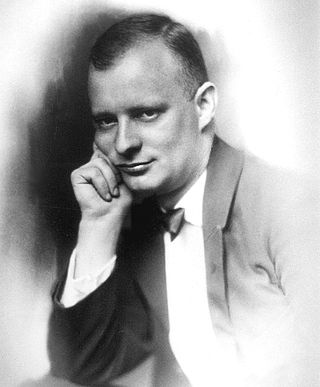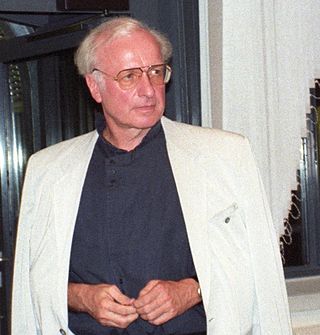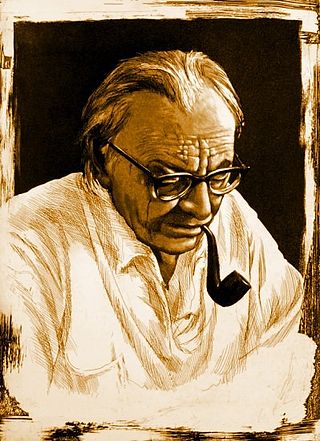
Paul Hindemith was a German and American composer, music theorist, teacher, violist and conductor. He founded the Amar Quartet in 1921, touring extensively in Europe. As a composer, he became a major advocate of the Neue Sachlichkeit style of music in the 1920s, with compositions such as Kammermusik, including works with viola and viola d'amore as solo instruments in a neo-Bachian spirit. Other notable compositions include his song cycle Das Marienleben (1923), Der Schwanendreher for viola and orchestra (1935), the opera Mathis der Maler (1938), the Symphonic Metamorphosis of Themes by Carl Maria von Weber (1943), and the oratorio When Lilacs Last in the Dooryard Bloom'd (1946), a requiem based on Walt Whitman's poem. Hindemith and his wife emigrated to Switzerland and the United States ahead of World War II, after worsening difficulties with the Nazi German regime. In his later years, he conducted and recorded much of his own music.

Opera in German is that of the German-speaking countries, which include Germany, Austria, and the historic German states that pre-date those countries.

Gerd Albrecht was a German conductor.

Palestrina is an opera by the German composer Hans Pfitzner, first performed in 1917. The composer referred to it as a Musikalische Legende, and wrote the libretto himself, based on a legend about the Renaissance musician Giovanni Pierluigi da Palestrina, who saves the art of contrapuntal music (polyphony) for the Church in the sixteenth century through his composition of the Missa Papae Marcelli. The wider context is that of the European Reformation and the role of music in relation to it. The character of Cardinal Borromeo is depicted, and a General Congress of the Council of Trent is the centrepiece of act 2.

Sancta Susanna is an early opera by Paul Hindemith in one act, with a German libretto by August Stramm. Composed over a two-week period in January/February 1921, its premiere was on 26 March 1922, at the Oper Frankfurt.

George Alexander Albrecht was a German conductor and composer, who also worked as a musicologist and academic teacher. A prolific composer at a young age, he was Generalmusikdirektor (GMD) of the Staatsoper Hannover from 1965 for 30 years, where he led not only the major operas by Mozart and stageworks by Wagner, but contemporary composers, such as Aribert Reimann's Troades in 1987. He was GMD of the Nationaltheater Weimar from 1996, and taught at the Hochschule für Musik Franz Liszt, Weimar. Albrecht promoted the works of neglected composers such as Wilhelm Furtwängler, Hans Pfitzner, and Erwin Schulhoff.
Literaturoper, a term coined by the German music critic Edgar Istel, describes a genre of opera that emerged during the late 19th century. When an existing play for the legitimate theatre is set to music without major changes and without the intervention of a librettist, a “Literaturoper” is the result. Although the term is German, it can be applied to any kind of opera, irrespective of style or language.

Murderer, the Hope of Women is a short Expressionist play written by the painter Oskar Kokoschka. It focuses more on the actions and appearances of its characters than on their dialogue. Its performance was received with much criticism, as it was a break from classical drama and part of the modernist avant-garde movement in German culture.

Mörder, Hoffnung der Frauen is an opera in one act by Paul Hindemith, written in 1919 on a German libretto by Oskar Kokoschka which he based on his play of 1907. The opera was the first in a triptych of expressionist one-act operas, the others being Das Nusch-Nuschi, and Sancta Susanna. They were the first operas written by Hindemith. The first two were premiered together in Stuttgart on 4 June 1921, all three were performed at the Oper Frankfurt in 1922.

Neues vom Tage is a comic opera in three parts by Paul Hindemith, with a German libretto by Marcellus Schiffer.

Die Harmonie der Welt is an opera in five acts by Paul Hindemith. The German libretto was by the composer.
Albin Swoboda Jr. was a German operatic bass-baritone. Born in Dresden, he was the son of tenor and actor Albin Swoboda Sr. and soprano Friederike Fischer; both of whom were luminaries of the "Golden Age" of Viennese operetta. His grandfather, Joseph Wilhelm Swoboda, also had an important career as a tenor and opera director in Vienna. In 1910 he became romantically involved with opera singer Anna Sutter. Sutter had broken off a relationship with conductor Aloys Obrist around the same time, and Obrist became highly distraught by the situation. On 29 June 1910, Obrist broke into Sutter's apartment, murdered her, and committed suicide in the presence of Swoboda who was unable to stop him.

Gabriele Schnaut was a German classical singer who started her operatic career as a mezzo-soprano in 1976 and changed to dramatic soprano in 1985. She performed at the Bayreuth Festival from 1977, in the filmed Jahrhundertring, to 2000. After a breakthrough performance as Richard Wagner's Isolde at the Hamburgische Staatsoper in 1988, she became a leading dramatic soprano on the stages of the world in roles such as Wagner's Brünnhilde and Richard Strauss' Elektra. From 2008, she ventured into dramatic mezzo-soprano character roles such as Klytämnestra in Elektra, Herodias in Salome and Kostelnicka Buryjovka in Leoš Janáček's Jenufa.

Franz Grundheber is a German operatic baritone. At the Hamburg State Opera, he performed over 150 roles from 1966. His voice is flexible enough to sing Italian opera as well as Wagner roles and contemporary opera; he is a stage presence in acting and singing. He has performed at major international opera houses and is known for his performance of the title role of Alban Berg's Wozzeck, filmed for DVD in 1994 in a production staged by Patrice Chéreau.

Erna Ellmenreich was a German operatic soprano, a member of the Staatstheater Stuttgart. She performed there leading parts and several premieres, including Ariadne auf Naxos by Strauss and works by Paul Hindemith.
Reinhold Fritz was a German operatic bass-baritone. He was engaged at the Stuttgart Court Opera for 25 years and was awarded the title Kammersänger. He performed a broad repertoire of both serious and comic roles, and participated in world premieres including the first version of Ariadne auf Naxos by Richard Strauss, Siegfried Wagner's An allem ist Hütchen schuld! and Hindemith's Das Nusch-Nuschi. Fritz was dismissed in 1933 under the Nazi regime because his wife was Jewish.

Prometheus is an opera by Carl Orff. The opera's Greek text is based on the drama by Aeschylus, the only surviving part of his Prometheus trilogy. Since Aeschylus's text in Ancient Greek has been directly set to music without alterations or cuts, Orff's score qualifies as one of the most typical examples for the operatic genre of Literaturoper. The premiere took place on March 24, 1968, at Staatstheater Stuttgart under the direction of Ferdinand Leitner in a production by Rudolf Sellner with sets and costumes by Teo Otto.

Wilibald Nagel (also Willibald Nagel, was a German musicologist and music critic.

Klaviermusik mit Orchester, Op. 29, is a 1923 piano concerto by Paul Hindemith. Subtitled Klavier nur linke Hand, it is a piano concerto for the left hand alone. It was commissioned by the pianist Paul Wittgenstein, who lost his right arm in the World War. He never played the piece, and when he died, his widow refused access to the score. The premiere, after her death, was played in Berlin in 2004, with Leon Fleisher as the soloist and the Berlin Philharmonic conducted by Simon Rattle. It was published by Schott.












